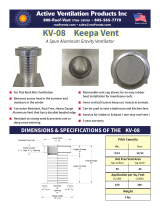
Installation Manual 2
Table of Contents
Safety Awareness
Safety Instructions
Safety Awareness ....................................................................... 2
Safety Instructions ...................................................................... 2
Certification and Code Requirements ....................................... 3
Ventilation Requirements........................................................... 3
Key Refrigerator Dimensions .................................................... 4
Assemble the Enclosure for the Refrigerator ............................ 4
Install the Lower and Upper Vents ............................................. 4
Install the Decorative Door panels (nonmetal door models).... 6
Install the Refrigerator................................................................ 7
Reverse the Door Swing-Nonmetal Doors (optional) ............... 7
Reverse the Door Swing-Metal Doors (optional)....................... 8
Connect the Ice Maker (N64XIM, N64XIMXX, N84XIM, and
N84XIMXX models) ............................................................. 9
Connect the water supply line............................................. 9
Connect the Electrical Components .......................................... 9
Connect the 120 volts AC supply ...................................... 10
Connect the 12 volts DC supply........................................ 10
Connect the Propane Gas Components ................................. 10
Connect the propane gas supply system......................... 10
Examine the gas supply system for leaks.........................11
Ignition and Start Up ..................................................................11
Ignition and start up (N64X, N64XXX, N64XIM, N64XIMXX,
N84X, N84XXX, N84XIM, and N84XIMXX models) .....11
Ignition and start up (N62X, N62XX, N82X, and N82XX
models)...................................................................... 12
Do a test of the gas safety valve........................................ 12
Shut down-all models....................................................... 12
Fault Codes (N62X, N62XX, N82X, and N82XX models) ........ 13
Fault Codes (N64X, N64XXX, N64XIM, N64XIMXX,
N84X, N84XXX, N84XIM, and N84XIMXX models) .... 14
Read this manual carefully and understand the contents before
you install the refrigerator.
Be aware of possible safety hazards when you see the safety
alert symbol on the refrigerator and in this manual. A signal
word follows the safety alert symbol and identifies the danger of
the hazard. Carefully read the descriptions of these signal
words to fully know their meanings. They are for your safety.
WARNING: This signal word means a hazard, which if
ignored, can cause dangerous personal injury, death, or
much property damage.
CAUTION: This signal word means a hazard, which if
ignored, can cause small personal injury or much
property damage.
WARNING:
- This refrigerator is not approved for use as a free
standing refrigerator. It is equipped for the use of
propane gas only and can not be changed to use any
other fuels (natural gas, butane, etc.).
- Incorrect installation, adjustment, alteration, or mainte-
nance of this refrigerator can cause personal injury,
property damage, or both.
- Obey the instructions in this manual to install intake and
exhaust vents.
- Do not install the refrigerator directly on carpet. Put the
refrigerator on a metal or wood panel that extends the full
width and depth of the refrigerator.
- Do not allow anything to touch the refrigerator cooling
system.
- Propane gas can ignite and cause an explosion that can
result in property damage, personal injury, or death. Do
not smoke or create sparks. Do not use an open flame
to examine the propane gas supply line for leaks. Always
use two wrenches to tighten or loosen the propane gas
supply line connections.
- Make sure the electrical installation obeys all applicable
codes. See “Certification and Code Requirements”
section.
- Do not bypass or change the refrigerator’s electrical
components or features.
- Do not spray liquids near electrical outlets, connections,
or the refrigerator components. Many liquids are electri-
cally conductive and can cause a shock hazard, electrical
shorts, and in some cases fire.
- The refrigerator cooling system is under pressure. Do not
try to repair or to recharge a defective cooling system.
- The cooling system contains sodium chromate. The
breathing of certain chromium compounds can cause
cancer. The cooling system contents can cause severe
skin and eye burns, and can ignite and burn with an
intense flame. Do not bend, drop, weld, move, drill,
puncture, or hit the cooling system.
CAUTION:
- The rear of the refrigerator has sharp edges and corners.
To prevent cuts or abrasions when working on the
refrigerator, use caution and wear cut resistant gloves.



























